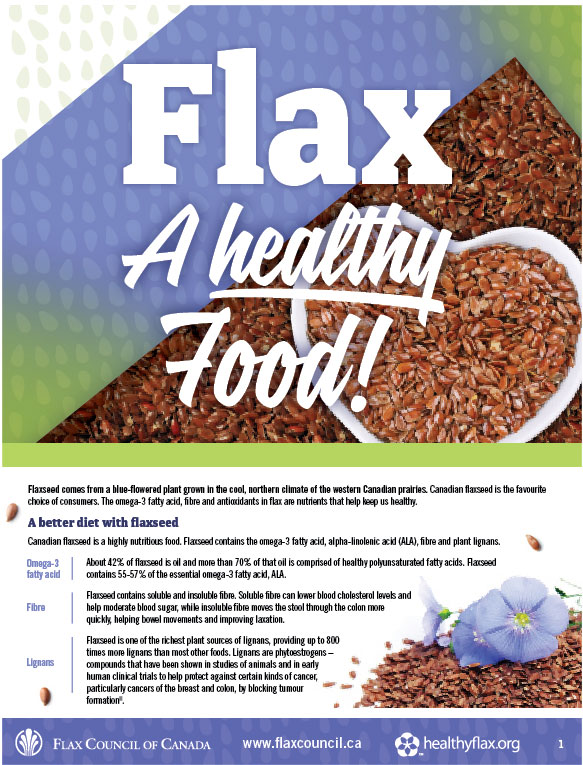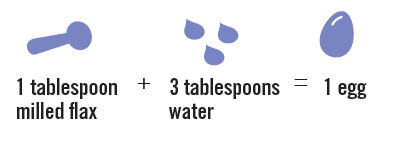
(Note: for the printed brochure, please visit our Literature Order Form page for more details)
Flax – A Healthy Food
Flax comes from the blue-flowered plant crop grown mainly in the cool, northern climate of the western Canadian prairies. Canadian brown flax seed is the favourite choice of consumers. The omega-3 fatty acid and fibre in flax are nutrients that help keep us healthy and well.
A Better Diet with Flax
Canadian flaxseed is a highly nutritious food. Flaxseed contains the omega-3 fatty acid, alpha-linolenic acid (ALA), fibre and plant lignans.
Omega-3 fatty acid. – About 42% of flaxseed is oil and more than 70% of that oil is comprised of healthy polyunsaturated fatty acids. Flaxseed contains 55-57% of the essential omega-3 fatty acid, ALA.
Fibre – Flaxseed contains soluble and insoluble fibre. Soluble fibre can lower blood cholesterol levels and help moderate blood sugar, while insoluble fibre moves the stool through the colon more quickly, helping bowel movements and improving laxation.
Lignans – Flaxseed is one of the richest plant sources of lignans, providing up to 800
times more lignans than most other foods. Lignans are phytoestrogens – compounds that have been shown in studies of animals and in early human clinical trials to help protect against certain kinds of cancer, particularly cancers of the breast and colon, by blocking tumour formation1.
A Health Claim for Flaxseed
For more detailed information and health tips go to:
The health-promoting components in flaxseed are associated with improved cardiovascular health. In fact, in 2014, Health Canada approved a health claim linking eating ground whole flaxseed to blood cholesterol lowering, a major risk factor for heart disease2.
The claim is only one of eleven approved in Canada. An example of the permitted claim for ground flaxseed is: “16 g (2 tablespoons) of ground flaxseed supplies 40% of the daily amount shown to help lower cholesterol”. The “daily amount” referred to in the claim is 40 g (5 tablespoons) of ground whole flaxseed to be consumed over three eating occasions in the day.
Other health benefits of flaxseed
The omega-3 fatty acids play a balancing role in the body. They correct imbalances in modern diets that lead to health problems.Nutritionists caution that the amount of omega-3 fatty acids eaten in North America no longer meets our bodies’ needs. You can balance your consumption of fatty acids by adding flaxseed to your diet.
A lower risk for heart disease. Flaxseed is the richest plant source of ALA. Studies show that flaxseed may reduce the risk of heart disease by preventing the buildup of harmful deposits in arteries3. In studies in which large groups of people were assessed to determine disease trends, increasing the ALA content of the diet corresponded to a decrease in risk of stroke and heart disease4. Flaxseed can assist in normalizing blood pressure5. And along with fibre, lignans and other antioxidants, ALA can reduce blood cholesterol – as supported by Health Canada – which may also lower the risk of heart disease.
Reduction of cancer risk. The link between diet and cancer is well known. Flaxseed lignans, in particular may be protective against some cancers (such as prostate, breast, lung and colon) because of their antioxidant activities and ability to reduce tumor number and blood vessel growth1,6.
Help with immune disorders. Lignans and ALA in flaxseed help to reduce inflammation that affects the body’s immune system1,7. Thus, flaxseed may be useful in reducing the risk of such immune disorders as rheumatoid arthritis and psoriasis.
Diabetes. Flaxseed has been shown to lower fasting blood glucose and glycated hemoglobin (HbA1c) and thus may be helpful in the management of diabetes mellitus8. In overweight or obese individuals with pre diabetes, flaxseed intake decreased glucose and insulin levels and improved insulin use9.
Proximate composition of flax based on common measures
| Form of flax |
Weight (g)
|
Common measure
|
Energy (kcal)
|
Total fat (g)
|
ALA (g)
|
Protein (g) |
Total
CHO (g) |
Total dietary fibre (g)
|
| Proximate analysis | 100 | – | 450 | 41.0 | 23.0 | 20.0 | 29.0 | 28.0 |
| Whole seed | 180 | 1 cup | 810 | 74.0 | 41.0 | 36.0 | 52.0 | 50.0 |
| 11 | 1 tbsp | 50 | 4.5 | 2.5 | 2.2 | 3.0 | 3.0 | |
| 4 | 1 tsp | 18 | 1.6 | 0.9 | 0.8 | 1.2 | 1.1 | |
| Ground seed | 130 | 1 cup | 585 | 53.0 | 30.0 | 26.0 | 38.0 | 36.0 |
| 8 | 1 tbsp | 36 | 3.3 | 1.8 | 1.6 | 2.3 | 2.2 | |
| 2.7 | 1 tsp | 12 | 1.1 | 0.6 | 0.5 | 0.8 | 0.8 | |
| Flax oil | 100 | – | 884 | 100.0 | 57.0 | – | – | – |
| 14 | 1 tbsp | 124 | 14.0 | 8.0 | – | – | – | |
| 5 | 1 tsp | 44 | 5.0 | 2.8 | – | – | – |
Based on a proximate analysis conducted by the Canadian Grain Commission. Fat content determined using the American Oil Chemists’ Society (AOCS) Official Method Am 2 – 93. Moisture content of 7.7%.
ALA = Alpha-linolenic acid, the essential omega-3 fatty acid.
CHO = Carbohydrate. Total Carbohydrate includes sugars and starches (1g) and total dietary fibre (28g) per 100g flax seeds.
(Source: Morris D.H. Flax: A health and nutrition primer. Winnipeg: Flax Council of Canada; 2003. p. 11)
Adding flaxseed to your diet
Flaxseed adds a pleasant, nutty taste to foods. You can buy it by the scoop, vacuum pack, bottle or capsule or find it in some favourite foods. Here are some ways to use flaxseed.
 Whole flaxseeds add colour and crunch to foods. You can sprinkle flaxseeds on top of home baking or mix them into a dough. However, to obtain maximum health benefit from flaxseed, you should first grind the seeds because whole seeds will pass through your system undigested.
Whole flaxseeds add colour and crunch to foods. You can sprinkle flaxseeds on top of home baking or mix them into a dough. However, to obtain maximum health benefit from flaxseed, you should first grind the seeds because whole seeds will pass through your system undigested.
 Grinding whole seeds breaks their tough outer skin, creating a light-coloured powder. Milled flaxseed is sold in a vacuum package or you can prepare it yourself in a coffee grinder. Sprinkle milled flaxseed on cereal or add it to doughs, batters, casseroles and other cooked foods.
Grinding whole seeds breaks their tough outer skin, creating a light-coloured powder. Milled flaxseed is sold in a vacuum package or you can prepare it yourself in a coffee grinder. Sprinkle milled flaxseed on cereal or add it to doughs, batters, casseroles and other cooked foods.
 Flaxseed oil is sold in bottles. The oil is extracted from whole flaxseeds using a cold-press process especially developed for plant oils. Pour flaxseed oil on fresh salads. Flaxseed oil provides ALA but no fibre or lignans.
Flaxseed oil is sold in bottles. The oil is extracted from whole flaxseeds using a cold-press process especially developed for plant oils. Pour flaxseed oil on fresh salads. Flaxseed oil provides ALA but no fibre or lignans.
 Flaxseed oil is also available in gel capsules and sold as a dietary supplement.
Flaxseed oil is also available in gel capsules and sold as a dietary supplement.
 Omega-3 enriched eggs contain extra omega-3 fatty acids from flaxseed fed to hens. You can use omega-3 eggs wherever you would use regular eggs – there’s no taste difference, only nutrition enrichment. If eaten on a regular basis, omega-3 enriched eggs make a substantial contribution to your need for omega-3 fatty acids. The caloric value and protein content of omega-3 enriched eggs are similar to that of regular eggs.
Omega-3 enriched eggs contain extra omega-3 fatty acids from flaxseed fed to hens. You can use omega-3 eggs wherever you would use regular eggs – there’s no taste difference, only nutrition enrichment. If eaten on a regular basis, omega-3 enriched eggs make a substantial contribution to your need for omega-3 fatty acids. The caloric value and protein content of omega-3 enriched eggs are similar to that of regular eggs.
 Omega-3 enriched foods, such as yogurt and milk, may contain flaxseed oil, while flaxseed baked goods, such as breads, can include milled or whole flaxseed.
Omega-3 enriched foods, such as yogurt and milk, may contain flaxseed oil, while flaxseed baked goods, such as breads, can include milled or whole flaxseed.
How much flax to eat
Like any high fibre food, flaxseed may upset your digestion if you add too much, too quickly. Healthy people should consume 5-10g (1-2 tsp) of flaxseed oil or 8-16g (1-2 Tbsp.) of milled flaxseed as part of a balanced diet.
For individuals at risk of developing, or who have heart disease, a daily intake of 40g (5 Tbsp.) of milled flaxseed is recommended by Health Canada.
Storing Flaxseed
Whole Flaxseed:
You can store whole flaxseed, which is clean, dry and of good quality, at room temperature for up to a year.
Milled Flaxseed:
To keep flaxseed fresh, you should grind it as you need it. You can keep milled flaxseed refrigerated in an airtight, opaque container for up to 30 days.
Flaxseed substitutions in foods
Fat or Oil Substitution Instructions: Use a 3:1 ratio when substituting flaxseed for oil in a recipe. For example, 3 tablespoons of milled flaxseed can replace 1 tablespoon of butter, margarine, shortening or vegetable oil.
Egg Substitution Instructions: For every egg being replaced, mix 1 tablespoon milled flaxseed with 3 tablespoons water in a small bowl and let sit for one or two minutes. The mixture will become gel-like. Add to your recipe as you would an egg.

References
1 Adolphe JL, et al. Br J Nutr. 2010;103:929-938.
2 Health Canada. 2014. Summary of Health Canada’s Assessment of a Health Claim about Ground Whole Flaxseed and Blood Cholesterol Lowering http://www.hc-sc.gc.ca/fn-an/alt_formats/pdf/label-etiquet/claims-reclam/assess-evalu/flaxseed-graines-de-lin-eng.pdf.
3 Francis AA, et al. Am J Physiol Heart Circ Physiol. 2013; 304: H1743-51.
4 Pan A, et al. Am J Clin Nutr. 2012;96:1262-1273.
5 Rodriguez-Leyva D, et al. Hypertension 2013;62:1081-1089.
6 Flower G, et al. Inter. Canc. Ther. 2013;13(3):181-192.
7 Hutchins AM, et al. Nutr. Res. 2013; 33(5):367-75.
8 Mani UV, et al. J. Diet. Suppl. 2011; 8(3):257-65.
9 Winnik S, et al. Eur Heart J. 2011; 32(20):2573-84.




